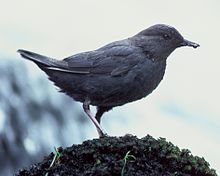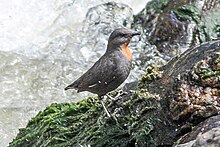Dipper
| Dippers | |
|---|---|

| |
| American dipper (Cinclus mexicanus) | |
| Scientific classification | |
| Domain: | Eukaryota |
| Kingdom: | Animalia |
| Phylum: | Chordata |
| Class: | Aves |
| Order: | Passeriformes |
| Superfamily: | Muscicapoidea |
| Family: | Cinclidae Sundevall, 1836 |
| Genus: | Cinclus Borkhausen, 1797 |
| Type species | |
| Cinclus hydrophilus[1] Borkhausen, 1797
| |

| |
| Distribution map
White-throated dipper
Brown dipper
American dipper
White-capped dipper
Rufous-throated dipper
| |
| Phylogeny of the dippers[2] |
Dippers are members of the genus Cinclus in the bird family Cinclidae, so-called because of their bobbing or dipping movements. They are unique among passerines for their ability to dive and swim underwater.
Taxonomy
The genus Cinclus was introduced by the German naturalist Moritz Balthasar Borkhausen in 1797 with the white-throated dipper (Cinclus cinclus) as the type species.[3][4] The name cinclus is from the Ancient Greek word kinklos that was used to describe small tail-wagging birds that resided near water.[5]
Cinclus is the only genus in the
The genus contains five species:[7]
- White-throated dipper or European dipper, Cinclus cinclus
- Brown dipper Cinclus pallasii
- American dipper Cinclus mexicanus
- White-capped dipper Cinclus leucocephalus
- Rufous-throated dipper Cinclus schulzii
A 2002
Description

Dippers are small, chunky, stout, short-tailed, short-winged, strong-legged birds. The different species are generally dark brown (sometimes nearly black), or brown and white in colour, apart from the rufous-throated dipper, which is brown with a reddish-brown throat patch. Sizes range from 14–22 cm (5.5–8.7 in) in length and 40–90 g (1.4–3.2 oz) in weight, with males larger than females. Their short wings give them a distinctive whirring flight.[8][9][10] They have a characteristic bobbing motion when perched beside the water, giving them their name. While under water, they are covered by a thin, silvery film of air, due to small bubbles being trapped on the surface of the plumage.[9]
Distribution and habitat
Dippers are found in suitable freshwater habitats in the highlands of the Americas, Europe and Asia. In Africa they are only found in the Atlas Mountains of Morocco. They inhabit the banks of fast-moving upland rivers with cold, clear waters, though, outside the breeding season, they may visit lake shores and sea coasts.[9]
Adaptations
Unlike many water birds, dippers are generally similar in form to many terrestrial birds (for example, they do not have
The high
Behaviour
Food
Dippers
Breeding
Linear breeding territories are established by pairs of dippers along suitable rivers, and maintained against incursion by other dippers. Within their territory the pair must have a good nest site and roost sites, but the main factor affecting the length of the territory is the availability of sufficient food to feed themselves and their broods. Consequently, the length of a territory may vary from about 300 metres (1,000 feet) to over 2,500 metres (8,200 feet).[9]
Dipper nests are usually large, round, domed structures made of moss, with an internal cup of grass and rootlets, and a side entrance hole. They are often built in confined spaces over, or close to, running water. The site may be on a ledge or bank, in a crevice or drainpipe, or beneath a bridge. Tree sites are rare.[9]
The usual clutch-size of the three northern dipper species is four or five; those of the South American species is not well known, though some evidence suggests that of the rufous-throated dipper is two.
Communication
Dippers' calls are loud and high-pitched, being similar to calls made by other birds on fast rivers; the
Conservation

Dippers are completely dependent on fast-flowing rivers with clear water, accessible food and secure nest-sites. They may be threatened by anything that affects these needs such as water pollution, acidification and turbidity caused by erosion. River regulation through the creation of dams and reservoirs, as well as channelization, can degrade and destroy dipper habitat.[9]
Dippers are also sometimes
Despite threats to local populations, the conservation status of most dipper species is considered to be of
References
- ^ "Cinclidae". aviansystematics.org. The Trust for Avian Systematics. Retrieved 2023-07-15.
- ^ .
- ^ Borkhausen (1797). Deutsche Fauna, oder, Kurzgefasste Naturgeschichte der Thiere Deutschlands. Erster Theil, Saugthiere und Vögel (in German). Frankfurt am Main: Varrentrapp und Wenner. p. 300.
- ^ Mayr, Ernst; Greenway, James C. Jr, eds. (1960). Check-list of Birds of the World. Vol. 9. Cambridge, Massachusetts: Museum of Comparative Zoology. p. 374.
- ISBN 978-1-4081-2501-4.
- ^ "ouzel". Oxford English Dictionary (Online ed.). Oxford University Press. (Subscription or participating institution membership required.)
- ^ Gill, Frank; Donsker, David, eds. (2019). "Dippers, leafbirds, flowerpeckers, sunbirds". World Bird List Version 9.1. International Ornithologists' Union. Retrieved 9 February 2019.
- ISBN 978-1-4067-4576-4.
- ^ ISBN 0-85661-093-3.
- ^ Robbins, C.S.; Bruun, B.; & Zim, H.S. (1966). Birds of North America. Western Publishing Company: New York.
- ^ "Country diary: it looks like a songbird, but the dipper is aquatic to its bones". www.theguardian.com. 7 April 2018. Retrieved 22 October 2023.
- ^ S2CID 7227306.
- S2CID 242827109. Retrieved 11 February 2019. The text is identical to Volume 10 of the print edition published in 2005.
- .
- S2CID 91058122.
- ^ Tyler, S.J. (1994). "The Yungas of Argentina: in search of Rufous-throated Dippers Cinclus schulzi" (PDF). Cotinga. 2: 38–41.
- ^ Salvador, S.; Narosky, S.; Fraga, R. (1986). "First description of the nest and eggs of the red-throated dipper in northwestern Argentina". Gerfaut. 76: 63–66.
- ^ "European Longevity Records". Euring. Retrieved 13 February 2019.
- ^ "Longevity Records of North American Birds". United States Geological Survey. Retrieved 13 February 2019.
- ^ J., Martens; Geduldig, G. (1990). "Acoustic adaptations of birds living close to Himalayan torrents". Proc. Int. 100 DO-G Meeting. Bonn: Current Topics Avian Biol. pp. 123–131.
- IUCN Red List of Threatened Species. International Union for Conservation of Nature. Retrieved 13 February 2019.
Further reading
- ISBN 0-85661-093-3
External links
- ITIS – Cinclus
- Dipper pictures Archived 2012-03-04 at the Wayback Machine in nature photographer Janne Heimonen's photo gallery
- Dipper videos on the Internet Bird Collection
